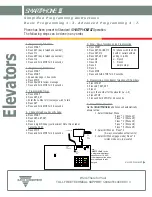
TD 92816EN
17-July 2012 / Ver. B
38
Programming and Installation Manual
Care Phone
No. of digits
Here you can specify whether one or two digits at the end of the alarm code
must be replaced. The alternatives are <Repl. 1 digit> and <Repl. 2 digits>.
Protocol
Specifies which communication protocols are to be used for the communication.
What protocols you can choose between is defined by the software variant. The
last menu choice, BS8521 PIN, is only used when the protocol BS8521 is used.
Then a code is registered which gives the alarm central the access to change
parameters in the Care Phone by entering this code.
>Protocol A< to >Protocol J< >Nightmode N< >Temp redir. V< >Protocol a< to >
Protocol h< >Nightmode< >Temp redir. v< >BS8521 PIN<
Sequences
This menu has sub-menus, which mainly manage the order in which telephone
numbers and addresses shall be called / contacted and for which alarm types.
>Def. sequence< >Def. alarm type< >Cascading< >Repeat seq.< >Demand
disconnection<
Def. sequence
Has a submenu where you can define the sequences, that is, in which order the
alarm numbers and Internet addresses of alarm receivers should be contacted if
no one responds to the alarm. See Section 3.4 for more detailed description.
>Sequence 1< to >Sequence 16<
Note:
Upper-case letters stand for numbers and lower case letters for addresses!
Def. alarm type
Has a submenu where you select the alarm types to call as per the sequence. See
Section 3.3 for more detailed description.
>Medical Alarm< Passive Alarm< >Acc./Mains< >Fire< >Person protect< >Plus<
>Emerg./Remind.< >Assistance < >User defined< >Test Alarm< >Bed/Carp./
Door< >Silent/Speech<
Silent/Speech
In a submenu you can for user-defined alarm types and for door, carpet and bed
alarms indicate if the alarm should be with speech, i.e., that speech contact is
connected with the person who receives the alarm, or of it should be a silent
alarm, that is, no talk contact is connected.
>User defined< >Bed/Carp./Door<
Cascading
Here you can choose the order of the sequences. If, for example, under
>Sequence 1< you choose <Sequence 3>, then an alarm that is set to call
according to sequence 1 shall continue to call as sequence 3 when all attempts
to sequence 1 is completed. You cannot create a loop by referring sequence 1 to
sequence 2 and sequence 2 to sequence 1. However, if you chose to repeat
sequences, they will run several times. Maximum of 40 attempts can be made in
total (100 attempts for the alarm type Plus Alarm).
>Sequence 1< to >Sequence 8<
















































